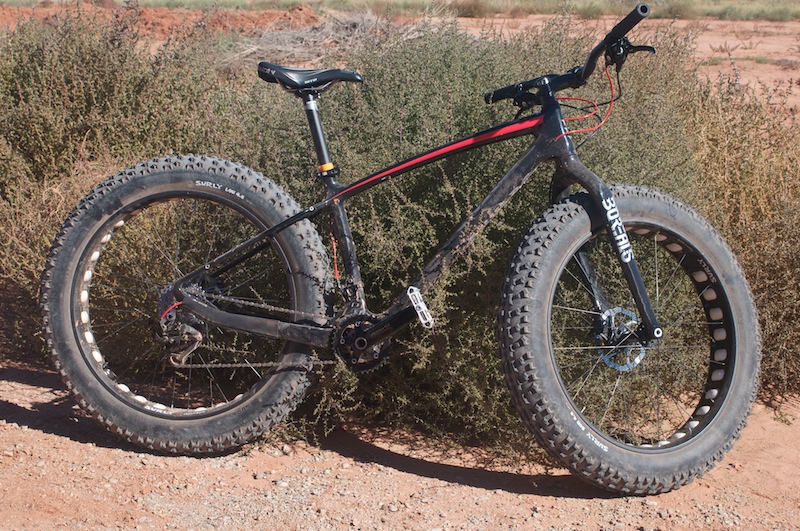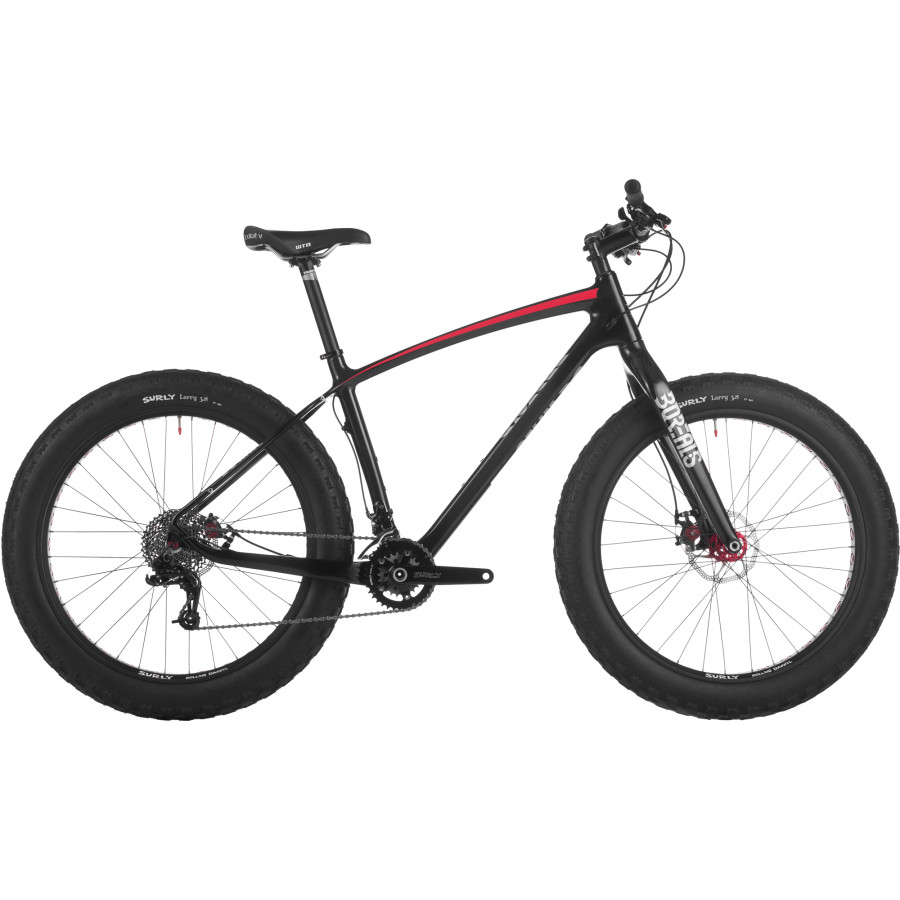
Fat Bikes, with their extra wide tires that excel on snow and sand, have exploded in popularity in the past five years. Borealis, a tiny company in Colorado, came on the scene this year with its first bike, the Yampa, and immediately pushed fat bike technology so far forward that everyone else is trying to catch up.
The Yampa has been hailed as a three-bike-quiver in one, the lightest fat bike on the planet and the first carbon fat bike to clear 4.8 inch tires. We’ve raced and played on this bike for a season and have been universally blown away by its spectacular performance.
The Yampa is available in a couple models: the XX1 (which I tested) comes compete at $5,549 and a frame weight of a remarkable 2.79 pounds. The X.9/X.0 costs $3,599. The frame-only costs $1,799, and a frame and fork is $2,249.

The first thing you notice about the Yampa is weight; it is really light. Borealis showed up last fall at Interbike, the bike industry’s largest event, with a 21lb fat bike hanging on a scale—about ten pounds lighter than the standard fat bike. It remains the lightest fat bike on the market, and the difference between a standard fat bike like mine (an aluminum 9:ZERO:7) and this one is HUGE.
See page two for more images and other editors’ opinions about the Borealis Yampa.
Look fast, ride fast; that’s the way it works and Yampa looks fast as hell. Stealth black with hits of red on the top tube and hubs makes it look evil, matching the high-tech build.

The Borealis guys got the geometry of this bike right. The chainstay is relatively long, which is great for snow. Longer chainstays push the rear wheel further behind the rider, which helps the bike track straighter because the wheelbase is elongated.
Additionally, when the rear wheel slips or slides sideways, which happens all the time when riding snow and ice, the rider does not get thrown sideways as violently as one would on a bike with a shorter chainstay. For comparison, the Yampa’s chainstay is 1 inch longer than the Salsa Beargrease.
The Yampa has a 69.8 degree fork angle, which is toward the steeper, quicker end of the spectrum. A steeper fork angle helps a bike get around corners nimbly, and this is particularly noticeable on dry terrain. The Yampa is nearly always labeled “fun” by testers, and that’s likely because of the responsive front end that is also very light.

Apart from the frame itself, the most important upgrade a bike can get is better wheels. So needless to say I was most happy to test Borealis’ carbon wheels, the Carbondales. They proved to be an easy-to-use, light tubeless option. Those of us who have tried to go tubeless with our current fat wheels are used to long battles setting them up.
With the Carbondales, I inflated both in a matter of minutes using Orange Seal Sub Zero; it was awesome!
They have not lost pressure, even enduring the -30F Arrowhead! The drop in weight is very noticeable as well, and the wheels upgraded this bike from great to amazing.

We were happy to see the Yampa’s threaded bottom bracket, a feature that is preferred when performing maintenance on a bike ridden in the slushy nastiness of winter.
Overall, the XX1 build that we tested was nothing short of lust-worthy, the ultimate build. Super light with no real problems, the Yampa is a brilliant first effort from this start-up company worth supporting. The guys are great dudes who work very hard and love bikes.
A few minor criticisms: I’d like to see the front end stiffen up. I feel more front-end flex on this bike than I should, and much more than my bike (again, an aluminum 9:ZERO:7). I could not narrow down to whether the flex was coming from the headset, the fork, or the Carbondale wheels, but this front end is not as predictable as I think it could be.
Other possible changes could include elimination of rear fender mounts (nobody uses them) and a bit more clearance for those with meaty calves — I don’t hit my calves much on the snow, but on the dirt where I can really toss the bike around, I did rub the super wide stays.
Borealis has a winner here with its Yampa. Although the bike has room for improvement, it is a marvel of a machine. Nobody rides this bike without a big smile on their face. We are eagerly awaiting what big things this tiny company will do next.
—Tom Puzak is a contributing editor.






